Occurrence and Co-Occurrence of Mycotoxins in Cereal-Based Feed and Food
Abstract
:1. Introduction
2. Materials and Methods
2.1. Data Collection and Data Extraction
2.2. Development of a Structured Database on Occurrence and Co-Occurence of Mycotoxins
2.3. Data Analysis
2.4. Analysis of Occurrence Data
2.5. Analysis of Co-Occurrence Data
3. Results
3.1. Data Quality
3.2. Occurrence of Mycotoxins
3.2.1. Wheat
3.2.2. Maize
3.2.3. Barley
3.2.4. Oat
3.2.5. Rice
3.2.6. Rye
3.3. Co-Occurrence of Mycotoxins
3.4. Results of Multinomial Analysis
4. Discussion
5. Conclusions
Supplementary Materials
Author Contributions
Funding
Acknowledgments
Conflicts of Interest
References
- Gruber-Dorninger, C.; Jenkins, T.; Schatzmayr, G. Global mycotoxin occurrence in feed: A ten-year survey. Toxins 2019, 11, 375. [Google Scholar] [CrossRef] [PubMed] [Green Version]
- Ingenbleek, L.; Sulyok, M.; Adegboye, A.; Hossou, S.E.; Koné, A.Z.; Oyedele, A.D.; Kisito, K.J.C.S.; Dembélé, Y.K.; Eyangoh, S.; Verger, P.; et al. Regional Sub-Saharan Africa total diet study in Benin, Cameroon, Mali and Nigeria reveals the presence of 164 mycotoxins and other secondary metabolites in foods. Toxins 2019, 11, 54. [Google Scholar] [CrossRef] [PubMed] [Green Version]
- EFSA Panel on Contaminants in the Food Chain (CONTAM); Knutsen, H.K.; Alexander, J.; Barregård, L.; Bignami, M.; Brüschweiler, B.; Ceccatelli, S.; Cottrill, B.; Dinovi, M.; Edler, L.; et al. Risks for animal health related to the presence of zearalenone and its modified forms in feed. EFSA J. 2017, 15, 4851. [Google Scholar] [CrossRef] [Green Version]
- EFSA Panel on Contaminants in the Food Chain (CONTAM); Knutsen, H.K.; Alexander, J.; Barregård, L.; Bignami, M.; Brüschweiler, B.; Ceccatelli, S.; Cottrill, B.; Dinovi, M.; Grasl-Kraupp, B.; et al. Risks to human and animal health related to the presence of deoxynivalenol and its acetylated and modified forms in food and feed. EFSA J. 2017, 5, 4718. [Google Scholar] [CrossRef]
- EFSA Panel on Contaminants in the Food Chain (CONTAM); Knutsen, H.K.; Alexander, J.; Barregård, L.; Bignami, M.; Brüschweiler, B.; Ceccatelli, S.; Cottrill, B.; Dinovi, M.; Edler, L.; et al. Risks for animal health related to the presence of fumonisins, their modified forms and hidden forms in feed. EFSA J. 2018, 16, 5242. [Google Scholar] [CrossRef]
- Grenier, B.; Oswald, I.P. Mycotoxin co-contamination of food and feed: Meta-analysis of publications describing toxicological interactions. World Mycotoxin J. 2011, 4, 285–313. [Google Scholar] [CrossRef]
- Gonçalves, A.; Gkrillas, A.; Dorne, J.L.; Dall’Asta, C.; Palumbo, R.; Lima, N.; Battilani, P.; Venâncio, A.; Giorni, P. Pre- and postharvest strategies to minimize mycotoxin contamination in the rice food chain. Compr. Rev. Food Sci. Food Saf. 2019, 18, 441–454. [Google Scholar] [CrossRef]
- Gonçalves, A.; Palumbo, R.; Guimarães, A.; Gkrillas, A.; Dall’Asta, C.; Dorne, J.L.; Battilani, P.; Venâncio, A. The route of mycotoxins in the grape food chain. Am. J. Enol. Vitic. 2019, in press. [Google Scholar]
- Palumbo, R.; Gonçalves, A.; Gkrillas, A.; Logrieco, A.; Dorne, J.L.; Dall’Asta, C.; Venâncio, A.; Battilani, P. Mycotoxins in maize: Mitigation actions with a chain management approach. Phytopathol. Mediterr. 2019, in press. [Google Scholar]
- Torres, A.M.; Barros, G.G.; Palacios, S.A.; Chulze, S.N.; Battilani, P. Review on pre- and post-harvest management of peanuts to minimize aflatoxin contamination. Food Res. Int. 2014, 62, 11–19. [Google Scholar] [CrossRef]
- Torres, A.M.; Palacios, S.A.; Yerkovich, N.; Palazzini, J.M.; Battilani, P.; Leslie, J.F.; Logrieco, A.F.; Chulze, S.N. Fusarium Head Blight and mycotoxins in wheat: Prevention and control strategies across the food chain. World Mycotoxin J. 2019, 12, 333–355. [Google Scholar] [CrossRef]
- Rychlik, M.; Humpf, H.U.; Marko, D.; Danicke, S.; Mally, A.; Berthiller, F.H.; Lorenz, N. Proposal of a comprehensive definition of modified and other forms of mycotoxins including “masked” mycotoxins. Mycotoxin Res. 2014, 30, 197–205. [Google Scholar] [CrossRef] [PubMed] [Green Version]
- International Agency for Research on Cancer. Agents Classifed by the IARC Monographs Volumes 1–124. Available online: https://monographs.iarc.fr/agents-classified-by-the-iarc/ (accessed on 30 August 2019).
- Fremy, J.M.; Alassane-Kpembi, I.; Oswald, I.P.; Cottrill, B.; Van Egmond, H.P. A review on combined effects of moniliformin and co-occurring Fusarium toxins in farm animals. World Mycotoxin J. 2019, 12, 281–291. [Google Scholar] [CrossRef]
- Gkrillas, A.; Terciolo, C.; Neves, M.; Palumbo, R.; Dorne, J.L.; Battilani, P.; Oswald, I.P.; Dall’Asta, C. Comparative Toxicokinetics of mycotoxins, alone or in combination in different animal species: A review. Food Chem. Toxicol. 2020. accepted. [Google Scholar]
- Steinkellner, H.; Binaglia, M.; Dall’Asta, C.; Gutleb, A.C.; Metzler, M.; Oswald, I.P.; Parent-Massin, D.; Alexander, J. Combined hazard assessment of mycotoxins and their modified forms applying relative potency factors: Zearalenone and T2/HT2 toxin. Food Chem. Toxicol. 2019, 131, 110599. [Google Scholar] [CrossRef]
- European Commission. Regulation (574/2011) amending Annex I to Directive 2002/32/EC of the European Parliament and of the Council as regards maximum levels for nitrite, melamine, Ambrosia spp. and carry-over of certain coccidiostats and histomonostats and consolidating Annexes I and II thereto. Off. J. Eur. Union 2011, 159, 7–23. [Google Scholar]
- European Commission. Recommendations (165/2013) on the presence of T-2 and HT-2 toxin in cereals and cereal products. Off. J. Eur. Union 2013, 91, 12–15. [Google Scholar]
- European Commission. Commission Recommendation (EU) 2016/1319 of 29 July 2016 amending Recommendation 2006/576/EC as regards deoxynivalenol, zearalenone and ochratoxin A in pet food. Off. J. Eur. Union 2016, 208, 58–60. [Google Scholar]
- European Commission. Regulation (1881/2006) setting maximum levels for certain contaminants in foodstuffs. Off. J. Eur. Union 2006, 364, 4–24. [Google Scholar]
- European Commission. Commission Regulation (EU) No 165/2010 of 26 February 2010 amending Regulation (EC) No 1881/2006 setting maximum levels for certain contaminants in foodstuffs as regards aflatoxins. Off. J. Eur. Union 2010, 50, 8–12. [Google Scholar]
- European Commission. Recommendation 2006/576/EC on the presence of deoxynivalenol, zearalenone, ochratoxin A, T-2 and HT-2 and fumonisins in products intended for animal feeding. Off. J. Eur. Union 2006, 229, 7–9. [Google Scholar]
- EFSA. Standard Sample Description ver. 2.0. EFSA J. 2013, 11, 3424. [Google Scholar] [CrossRef]
- R Core Team. R: A Language and Environment for Statistical Computing. Available online: http://www.R-project.org/ (accessed on 22 July 2019).
- Toscano, P. MYCHIF Project Repository. Available online: https://mychifrep.fi.ibimet.cnr.it/owncloud/ (accessed on 22 July 2019).
- WHO. Assessment of Combined Exposures to Multiples Chemicals: Report of a WHO/IPCS International Workshop; WHO Press: Geneva, Switzerland, 2009. [Google Scholar]
- EFSA. Management of left-censored data in dietary exposure assessment of chemical substances. EFSA J. 2010, 8, 1557. [Google Scholar] [CrossRef] [Green Version]
- European Commission. Regulation (1126/2007) amending Regulation (EC) No 1881/2006 setting maximum levels for certain contaminants in foodstuffs as regards Fusarium toxins in maize and maize products. Off. J. Eur. Union 2007, 255, 14–17. [Google Scholar]
- Shi, H.; Schwab, W.; Yu, P. Natural occurrence and co-contamination of twelve mycotoxins in industry-submitted cool-season cereal grains grown under a low heat unit climate condition. Toxins 2019, 11, 160. [Google Scholar] [CrossRef] [Green Version]
- Malachová, A.; Stránská, M.; Václavíková, M.; Elliott, T.C.; Black, C.; Meneely, J.; Hajšlová, J.; Ezekiel, N.C.; Schuhmacher, R.; Krska, R. Advanced LC–MS-based methods to study the co-occurrence and metabolization of multiple mycotoxins in cereals and cereal-based food. Anal. Bioanal. Chem. 2018, 410, 801–825. [Google Scholar] [CrossRef] [Green Version]
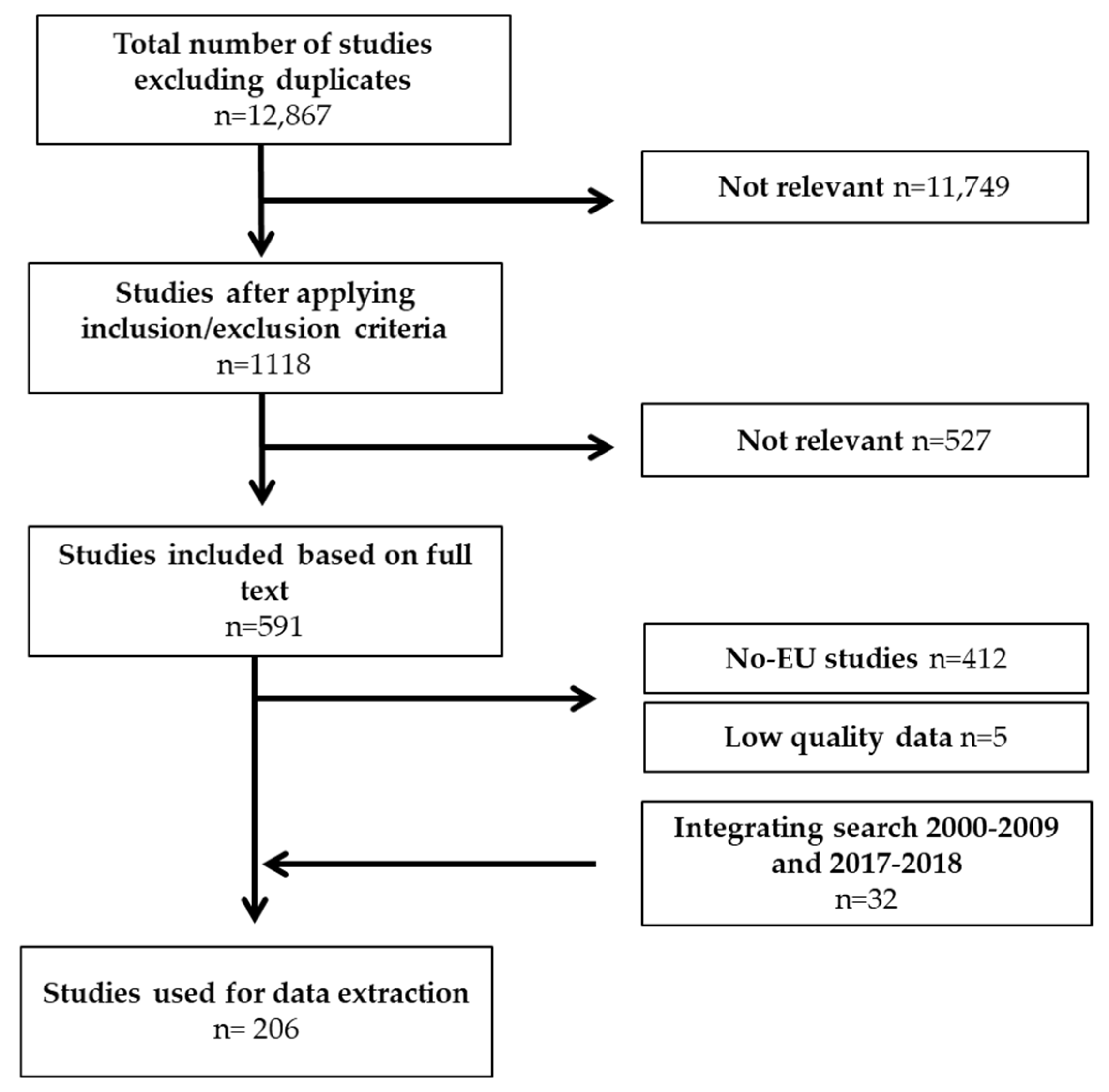
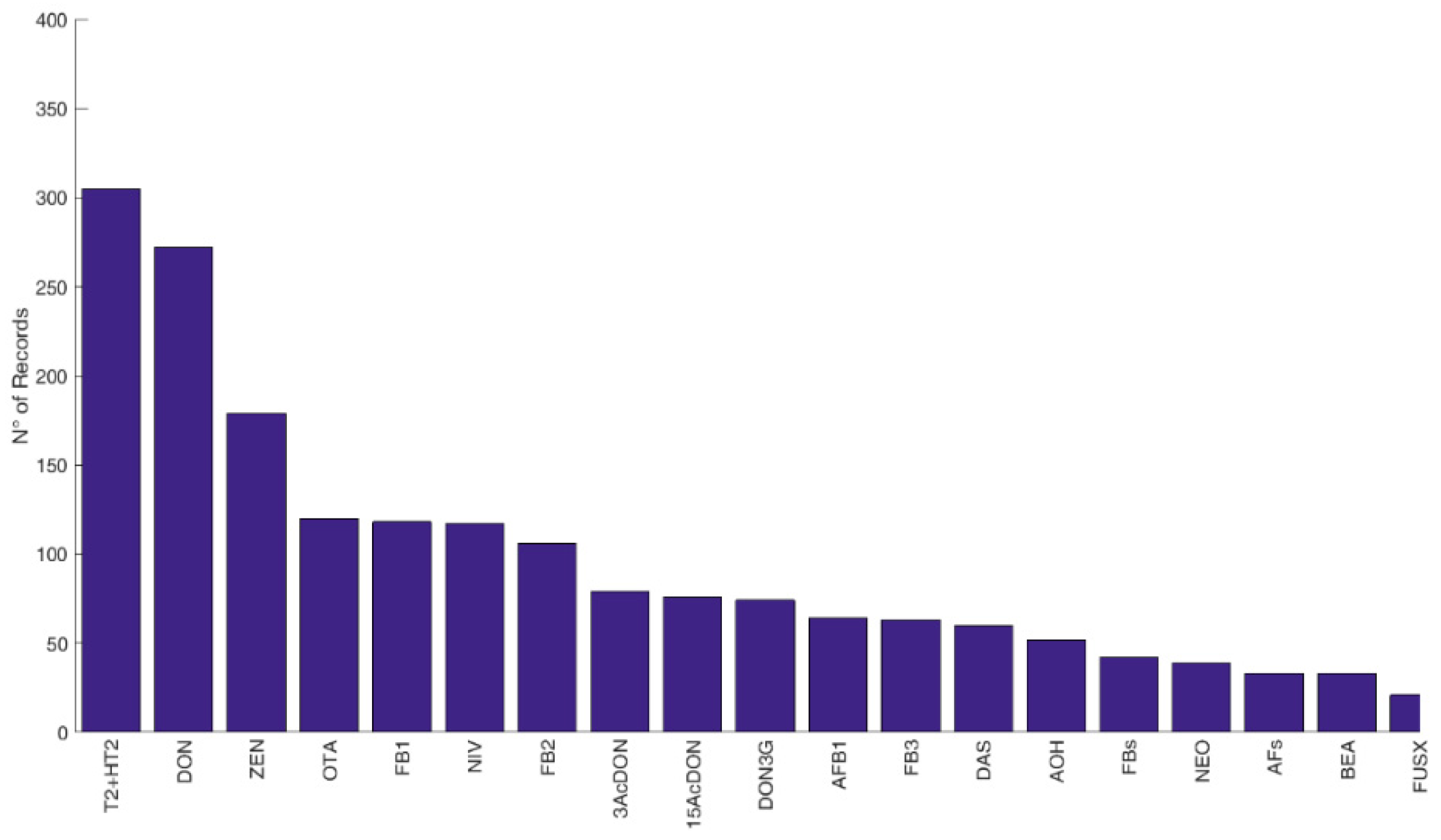



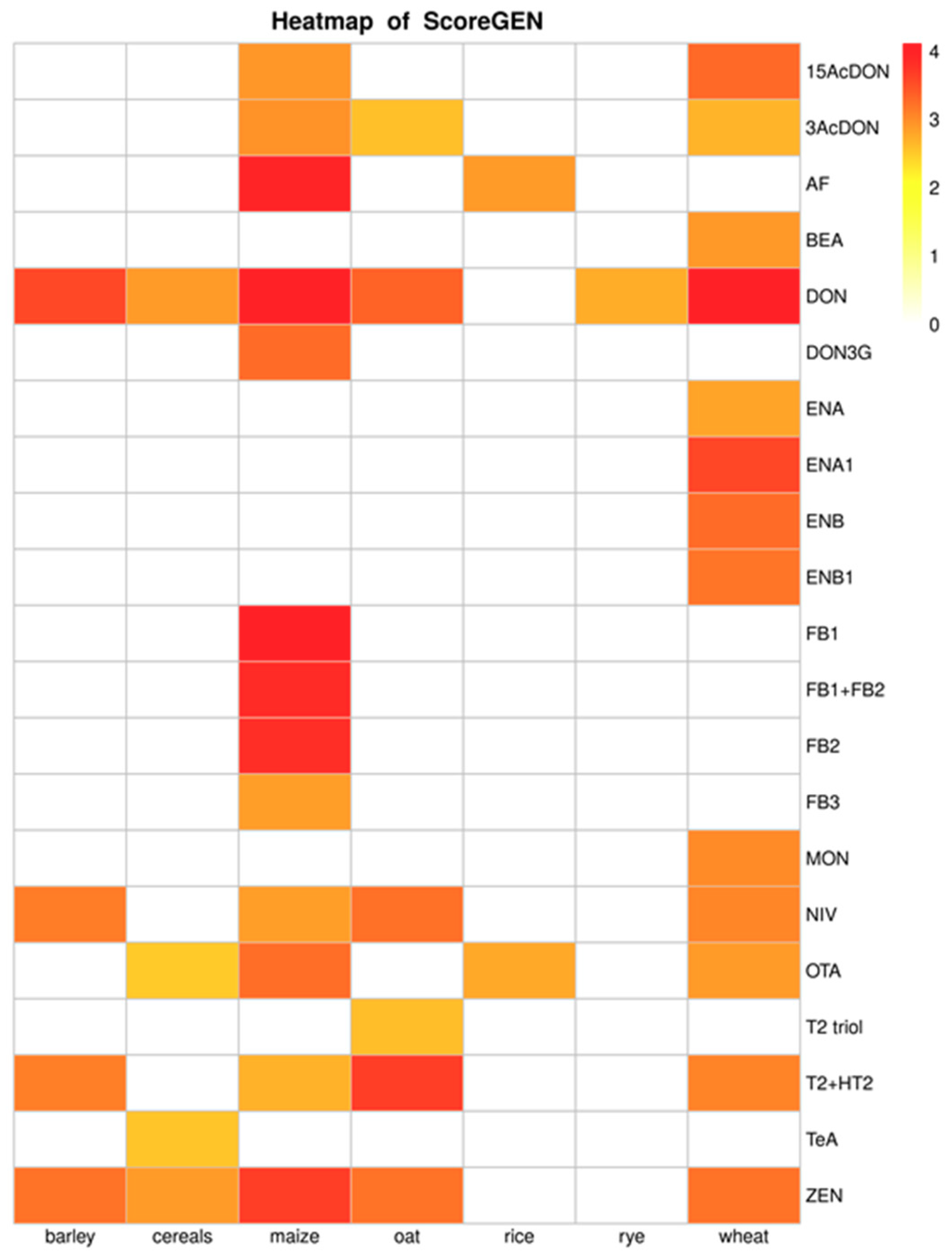
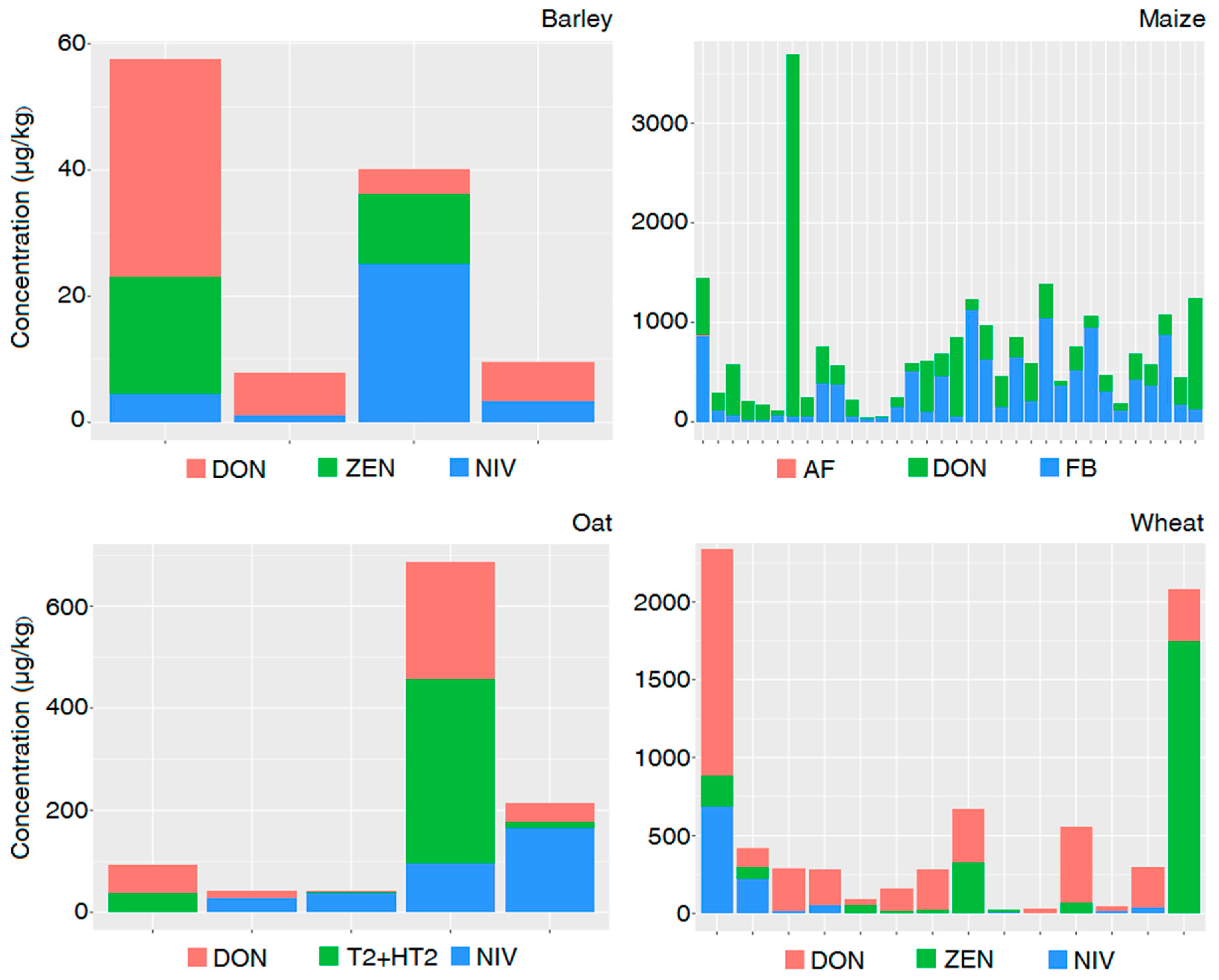
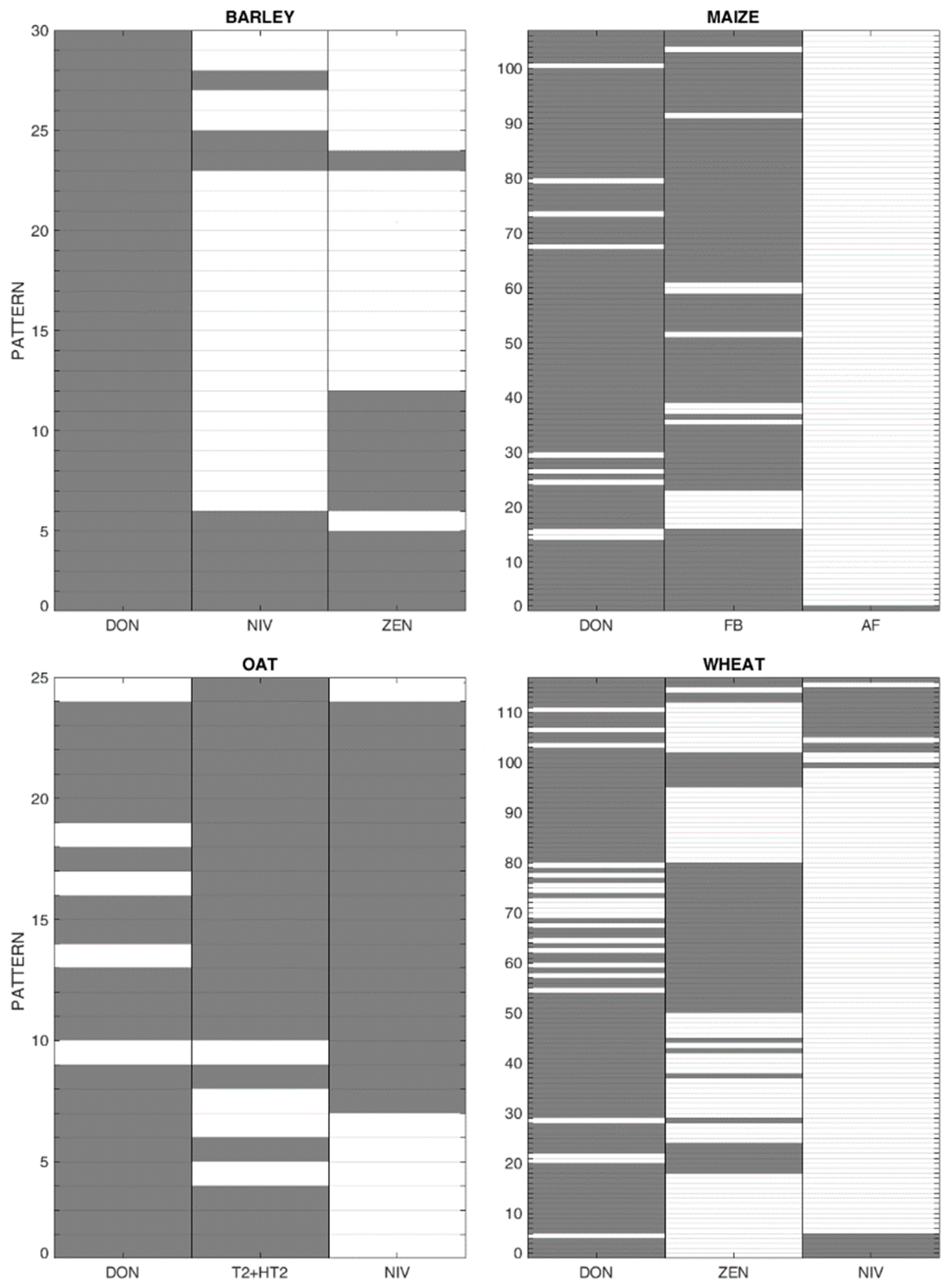
| Crop/Aggregation | N of Records 1 | <LOD 2 | <LOQ 3 | N of Co-Occ Studies 4 | N of Co-Occ Records 5 |
|---|---|---|---|---|---|
| Barley | 865 | 140 | 109 | 17 | 330 |
| Buckwheat | 6 | 3 | 0 | 1 | 4 |
| Cereals | 463 | 189 | 61 | 12 | 223 |
| Maize | 2362 | 1055 | 66 | 27 | 1443 |
| Oat | 740 | 150 | 81 | 14 | 374 |
| Rice | 520 | 297 | 26 | 8 | 343 |
| Rye | 236 | 75 | 14 | 10 | 111 |
| Sorghum | 101 | 62 | 9 | 2 | 51 |
| Spelt | 83 | 26 | 1 | 3 | 61 |
| Triticale | 127 | 48 | 0 | 3 | 13 |
| Wheat | 2860 | 1252 | 142 | 43 | 1646 |
| Others 6 | 43 | 32 | 0 | 3 | 13 |
| All | 8406 | 3329 | 509 | 482 | 4612 |
| N | Sub-Indices Code | Sub-Indices Meaning | Range | Normalization |
|---|---|---|---|---|
| 1 | Score numerosity | data availability | 6–332 | 0–1 |
| 2 | Score validity | percentage of good data available | 0–100 | 0–1 |
| 3 | CV score | coefficient of variation of toxin concentration | 0–1 | 0–1 |
| 4 | P sampleSize | total samples number | 1–48 | 0–1 |
| 5 | P agePaper | age of papers | 2001–2018 | 0–1 |
| 6 | P bibIntensity | bibliography intensity | 1–215 | 0–1 |
| 7 | P haveBounds | statistical information | 0–1 | 0–1 |
| Pattern | DON | NIV | ZEN | % | Pattern | DON | FB | AF | % |
| Barley | Maize | ||||||||
| 1 | 1 | 1.3 | 1 | 1 | 10.7 | ||||
| 2 | 1 | 0.8 | 2 | 1 | 1 | 0.5 | |||
| 3 | 1 | 1 | 4.5 | 3 | 1 | 13.1 | |||
| 4 | 1 | 20.5 | 4 | 1 | 1 | 0.3 | |||
| 5 | 1 | 1 | 32.9 | 5 | 1 | 1 | 74.4 | ||
| 6 | 1 | 1 | 25.8 | 6 | 1 | 1 | 1 | 1.0 | |
| 7 | 1 | 1 | 1 | 14.2 | |||||
| Pattern | DON | T2/HT2 | NIV | % | Pattern | DON | NIV | ZEN | % |
| Oat | Wheat | ||||||||
| 1 | 1 | 3.0 | 1 | 1 | 2.7 | ||||
| 2 | 1 | 5.0 | 2 | 1 | 0.2 | ||||
| 3 | 1 | 1 | 22.3 | 3 | 1 | 1 | 5.0 | ||
| 4 | 1 | 3.0 | 4 | 1 | 18.1 | ||||
| 5 | 1 | 1 | 18.8 | 5 | 1 | 1 | 46.1 | ||
| 6 | 1 | 1 | 25.4 | 6 | 1 | 1 | 15.0 | ||
| 7 | 1 | 1 | 1 | 22.5 | 7 | 1 | 1 | 1 | 12.9 |
© 2020 by the authors. Licensee MDPI, Basel, Switzerland. This article is an open access article distributed under the terms and conditions of the Creative Commons Attribution (CC BY) license (http://creativecommons.org/licenses/by/4.0/).
Share and Cite
Palumbo, R.; Crisci, A.; Venâncio, A.; Cortiñas Abrahantes, J.; Dorne, J.-L.; Battilani, P.; Toscano, P. Occurrence and Co-Occurrence of Mycotoxins in Cereal-Based Feed and Food. Microorganisms 2020, 8, 74. https://0-doi-org.brum.beds.ac.uk/10.3390/microorganisms8010074
Palumbo R, Crisci A, Venâncio A, Cortiñas Abrahantes J, Dorne J-L, Battilani P, Toscano P. Occurrence and Co-Occurrence of Mycotoxins in Cereal-Based Feed and Food. Microorganisms. 2020; 8(1):74. https://0-doi-org.brum.beds.ac.uk/10.3390/microorganisms8010074
Chicago/Turabian StylePalumbo, Roberta, Alfonso Crisci, Armando Venâncio, José Cortiñas Abrahantes, Jean-Lou Dorne, Paola Battilani, and Piero Toscano. 2020. "Occurrence and Co-Occurrence of Mycotoxins in Cereal-Based Feed and Food" Microorganisms 8, no. 1: 74. https://0-doi-org.brum.beds.ac.uk/10.3390/microorganisms8010074






